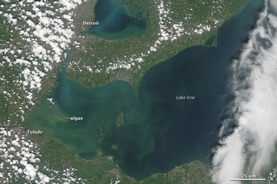Deadly Algae Are Everywhere, Thanks to Agriculture
Get used to algae blooms, they may be coming to a body of water near you
By David Biello
The rains come and water the spring shoots of another bounteous Midwestern corn crop in Ohio, Indiana and Michigan. The rains also wash phosphorus off farm fields and into creeks, streams and rivers. The waters flow into the shallowest of the Great Lakes—Lake Erie, which is just 18 meters deep on average and far shallower on its western edge. All that phosphorus doesn’t just help crops grow. When it reaches the lake it fuels the growth of mats of bright green algae, turning the water the color of pea soup. Such Microcystis cyanobacteria bear poisons, at least 80 different varieties of a toxin dubbed microcystin. And when the shallow waters deliver an algal bloom down to the right water intake pipes, an entire city like Toledo is left without water.
“Most water treatment plants are watching for the toxin,” says Don Scavia, environmental engineer, director of the Graham Environmental Sustainability Institute at the University of Michigan and an expert on such harmful algal blooms. “The options when it occurs are to treat it—very expensive—or to shut down.”
Such dangerous blooms are becoming more common, affecting all 50 states, according to the U.S. Environmental Protection Agency. Just last year a township near Toledo had to shut down its water supply due to a similar bloom. And such blooms are not confined to freshwater. Offshore, similar algal blooms create dead zones; microbes consuming dead algae use up all the available oxygen in the water, killing slow-moving and sessile sea life. Such dead zones are on the rise not just on the U.S. seaboards and interior waters but worldwide. The annual ocean dead zone at the mouth of the Mississippi River covered an area roughly the size of Connecticut this year, after reaching Massachusetts-proportions in 2013. Freshwater blooms like the one that shut down Toledo’s drinking water cost the U.S. hundreds of millions of dollars each year, and also occur in countries such as Brazil and China.
Warmer summertime temperatures, more powerful rainstorms and longer growing seasons—all conditions expected to strengthen as climate change continues—will only make conditions even more hospitable for such cyanobacteria, some of the oldest life on Earth. The algae have been blooming earlier and lingering later in recent years. And ecosystem changes in Lake Erie may be contributing to the problem. “The zebra and quagga mussels in Lake Erie might also be important because they do not eat the Microcystis species, favoring their growth over others,” Scavia notes.
The bloom that shut down water supplies for Toledo is just getting started, though the tap water is now drinkable again. It will persist into the fall, likely peaking in September. And such blooms are not confined to Lake Erie: similar blooms have happened in Green Bay on Lake Michigan and Lake Huron’s Saginaw Bay.
The microcystin toxin is quite dangerous—more potent at smaller doses than powerful pesticide DDT, neurotoxic mercury and even the poison cyanide. It can cause liver damage in humans as well as vomiting, diarrhea and abdominal pain. Its cousin, anatoxin, poisons the central nervous system. Treatment requires adding chemicals and carbon to filter out the toxins. And drinking water cannot simply be boiled to kill off the algae because this can burst the cyanobacterial cells, releasing yet more toxin into the water.
The states surrounding Lake Erie thought they had solved the algal bloom problem by eliminating phosphates in detergents that had been getting into Lake Erie via sewage treatment plants. These measures cut such phosphorus from nearly 30,000 metric tons per year to just over 10,000. But “changes in farming practices have contributed to increased runoff,” explains David Dempsey, a policy advisor at the International Joint Commission (IJC). The independent body was created in 1909 by Canada and the U.S. to deal with shared waters like the Great Lakes; it released a report on the subject, “A Balanced Diet for Lake Erie: Reducing Phosphorus Loadings and Harmful Algal Blooms,” (pdf) in February. “To some extent this is offsetting the improvements made by reducing phosphorus in detergents,” he adds.
Reducing phosphorus from farms will be much tougher challenge than cleaning sewage treatment plants, which was required by the U.S. Clean Water Act of 1972. So far, only voluntary programs have been put in place to fight runoff. “They aren’t enough,” says Rajesh Bejankiwar, leader of the IJC task force tackling phosphorus pollution in the Great Lakes. Farm fields in the Lake Erie Basin deliver nearly 640 grams of phosphorus per acre to that lake, or more than 60 percent of the phosphorus now reaching the water. As a result, the year 2011 saw the largest algal bloom in Lake Erie in recorded history. Exacerbating the problem are nutrients that flow in with waste from large animal farms as well as, still, the treated sewage from cities like Buffalo, Cleveland and Detroit.
The basic idea to cut back on runoff from farms is simple: apply only the right amount of fertilizer in a targeted way at the appropriate time exactly where it can do the most good for crops and have the least likelihood of simply running off in the rain. That means no more fall, winter or early spring application to prepare fields for the growing season, according to the IJC, among others. Buffer zones of foliage and wetlands can also help filter out the phosphorus but this marginal land has increasingly been used to grow yet more corn, as prices of the crop have risen in recent years, thanks to a federal mandate to make ethanol from corn as fuel for cars. “The most important thing that can be done is to reduce agricultural runoff,” Bejankiwar says. “Prevention is better than treatment.”
Source: Scientific American.




